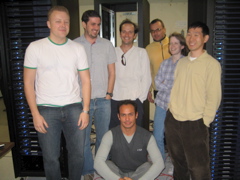|
|
| Marine data acquisition |
The seismic industry is probably the largest civilian user of high-performance computing in the world. In the past three decades it has been an early adopter of all the successive supercomputing technologies: starting from the first Cray vector computers, to the use of massively parallel computers like the Connection Machines. Now geophysical companies and oil companies rely on large installations of Linux Clusters to image seismic data within a useful turn-around time. Predicting the future of computer technology is a dangerous exercise, but whatever the future direction of scientific computing might be, Grid computing and/or use of the graphic-rendering hardware for numerical computation , it is likely that seismic imaging will be a massive user of those technologies.

|
| Celebrating the arrival on new SEP's cluster (2005) |
One of SEP's main goals is to develop the next generation of imaging algorithms. These algorithms may be too computationally intensive to be applied on industrial scale today, but they will become cost-effective as the computer industry drives computational costs down. An important class of advanced algorithms that we are actively investigating requires the iterative inversion of wave-equation operators. The performance of each iteration of these inversion processes on a a small data set (~10 square kilometers) requires several days to run on SEP's largest cluster (80 CPUs), and satisfactory results are achieved only after many iterations. To investigate the limitations of present methods and to devise new ones we must run such large tasks many times. We are thus always on the lookout for the latest high-performance computing innovations because the future of SEP depends on them.
